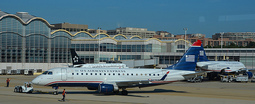Should DCA’s role in the region change?

Photo by Adam Fagen on Flickr.
US Airways is merging with American Airlines, and will then control most of DCA airport’s flights. Should it have to give up slots? What will that mean for small communities? Moreover, should DCA grow? How?
Last week, US Airways CEO Doug Parker testified before Congress about his pending merger with American. US Airways already is the dominant airline at DCA, and combined with American, will control 68% of the slots and 49% of passenger traffic.
Beyond the questions about what’s good for airfares and the aviation industry, what happens at DCA has a big effect on our region. The airport is far easier to reach from most central urban and suburban neighborhoods, where more and more people are living. If the region is growing in the core, should air travel grow there as well? How?
Everyone wants slots
DCA is one of only a few airports in the nation where regulations limit the number of flights. Carriers own “slots” which give them rights to one takeoff or landing per day. There are also limits on how many flights can operate in each hour.
These slots are extremely valuable, since many people will pay more to fly from convenient DCA instead of more distant (for most people) Dulles or BWI. JetBlue recently paid $40 million for slots to run 8 daily round trips.
Furthermore, DCA has a perimeter rule limiting most flights to cities no more than 1,250 miles away (far enough to get to Dallas but not Austin). There are a limited number of exceptions, including some Congress added last year, which gave us new flights from DCA to San Francisco, Portland, San Diego, Austin, and San Juan, as well as more flights to Los Angeles and Salt Lake City, which already had exemptions.
The Federal Aviation Administration and Department of Justice could require the combined airline to give up some DCA slots as part of a merger. United and Continental had to do this at Newark, for instance. However, US Airways currently uses many of its slots to fly to small cities around the East Coast. When JetBlue bought those 8 round trips, it didn’t do that; it added flights to Boston and Florida.
CEO Doug Parker, therefore, has been arguing that if his airline has to divest slots, other airlines will simply use them to fly to big cities that already have a lot of service. That will likely lower fares to those cities, but remove options to other cities. Some members of Congress sent a letter asking for US Airways/American to keep its slots so that their small communities can keep their flights.
What is the role of DCA?
This debate raises several important questions about how DCA fits into the region. It’s the most convenient airport for the greatest number of residents, while Dulles and BWI take longer to reach. Therefore, there’s some logic to the idea that short flights should leave from DCA, while the trek to a farther airport isn’t such a burden if the flight itself is longer as well.
Also, being most convenient, perhaps it makes sense to prioritize coverage over price. Price-sensitive flyers can go to BWI, where Southwest has a huge operation, and where other airlines’ fares are also generally lower.
Still, as the region grows in the core, it makes sense to think about how DCA could grow as well. Passenger traffic has grown 5.5%, while Dulles lost 6.4% of its traffic. Some of that is the rest of the new beyond-perimeter flights. Clearly, more people would rather fly from DCA. When the Silver Line opens, it might shift some more passengers to Dulles.
DCA has many limits on its size. With only one long-ish runway, it can’t handle large numbers of planes at once. Nothing is going to change that. It also has a legal cap on the number of gates, as well as the slot restrictions. Some of that placates Arlington, which has to cope with the noise from planes. On the other hand, those restrictions came about at a time that planes were much noisier than they are today.
The Metropolitan Washington Airports Authority has been primarily investing in Dulles Airport, with the newish AeroTrain, the Silver Line, and roadway projects. Ever since Dulles opened and the DCA perimeter went into effect, there’s been a general policy of trying to shift traffic there.
Make DCA bigger?
Should the region still try to build up Dulles and BWI and keep a lid on DCA? Just as letting the region’s core grow is more economically efficient and better for mobility, so is helping more people use the central airport. More planes can’t easily fly in and out of DCA, but they could be larger planes, if MWAA wanted to, and legally could, invest in more gates and more security screening capacity.
One slot can go to a plane of any size that fits at DCA, but many US Airways flights are on small regional jets which flyers reach by shuttle bus. That’s why the combined airline would only have half the airport’s passengers but 2/3 of the flights. With enough gate space, larger planes could use those slots and carry more people.
However, larger planes have to go to larger cities. US Airways flies so many small planes now because they match the level of demand. There’s particularly strong demand beyond the perimeter, and if the rule didn’t exist many more flights would be going to the west, but the rule is there to keep that demand at Dulles and BWI instead.
Which brings us back to the same central question: should DCA be a sort of niche airport with smaller planes to many little destinations, or an airport that tries to serve as much of the travel demand, close in to the center of the region, as possible? There’s no obvious answer.
